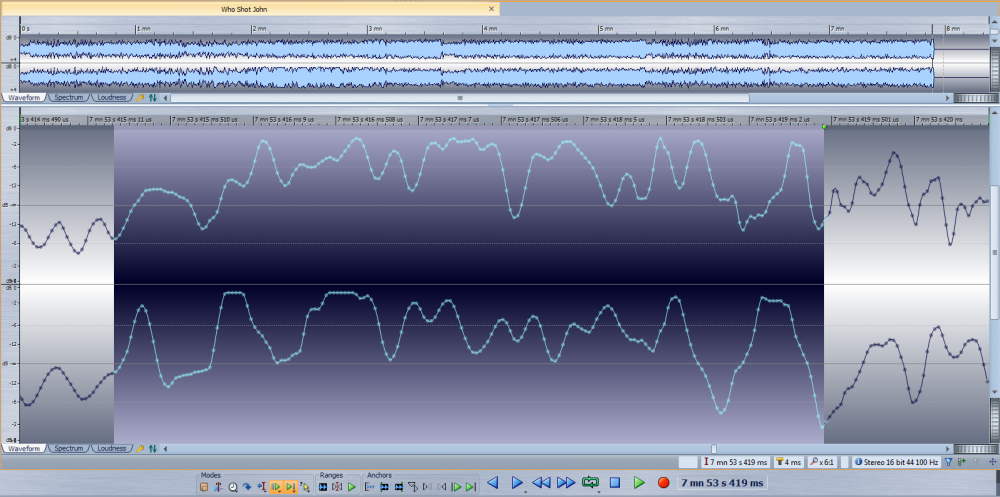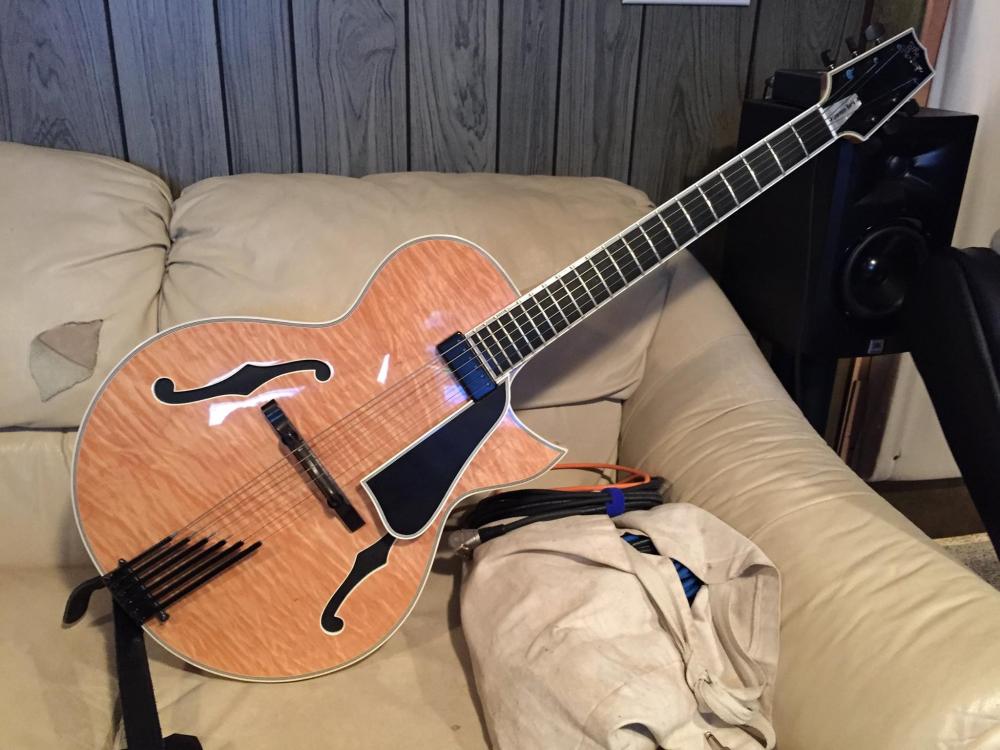-
Posts
12,717 -
Joined
-
Last visited
-
Days Won
1 -
Donations
0.00 USD
Content Type
Profiles
Forums
Events
Blogs
Posts posted by Jim Alfredson
-
-
Nice! Hard to find with that title, though.

-
Wow! Some amazing stuff popping up on YT lately. Here's Shirley Scott live in Spain in 1976 with a composition of Harold Vick's from her One For Me album (my favorite).
-
I just thought it would be interesting to do it that way. "If you play in 8, he'll take a beat."

Thanks! -
They do it all the time. That's why there's a huge market of esoteric analog mic preamps, compressors, 'vintage warmer' plugins, etc. It's also why a lot of studios / artists / engineers still record to tape and then transfer that into the digital realm for editing and mixing.
-
9 hours ago, Scott Dolan said:
It's great point. Which also makes one ask, "why don't the engineers add the distortion of vinyl to CDs?" I'd think the answer is rather obvious.
They do. There are all kinds of harmonic distortion plug-ins and tools available to the modern engineer if he/she or the producer wants that sound. One of the best is the Sonnox Oxford Inflator plug-in. This is a lot like the old Aural Exciter hardware units of yesteryear but much more flexible. I know that Peter Gabriel's engineer for example uses it on his vocals. It's also handy on drums and even on the mix bus (the entire mix) to add a bit of sparkle / energy to the track. Of course like anything else it can be overused.
-
Rare live Groove Holmes... ON VIDEO! This is the first video I've ever seen anywhere of Groove Holmes. WOW! Live in Spain in 1980.
https://www.youtube.com/results?search_query=groove+holmes+live+spain -
Those Argo releases are all I know that's out there. He just disappeared in the early 60's.
-
There is no difference in speaker wire. This has been proven again and again in double-blind tests. Unless you've engaged in your own double-blind testing, you cannot say "I hear a difference" with any real confidence. You think you hear a difference. But our senses are easily fooled. You've all experienced optical illusions, right? There are also auditory illusions, touch illusions, smell illusions, taste illusions, etc. That's why the scientific method has been so successful; because it is a tool that gives us the means to bypass our own confirmation biases, agendas, partiality, and the inherent weakness of our own senses.
Allow me to relate a little story. I'm good friends with a brilliant and extremely knowledgeable audio engineer / acoustician here in my hometown. I've learned everything I know about audio and audio engineering from him. He designs his own speakers that sell for five digit prices, he designs recording studios for major labels & artists, and he has incredibly trained and sensitive ears. He's able to hear EQ changes within .5 db increments and can tell you exactly what frequency is poking out of a mix without using a visual cue like a spectral analyzer.
When we were mixing and mastering my progressive rock project (THEO - The Game of Ouroboros), we had to upsample the mixes from the recorded format (24bit, 44.1kHz, tracked at my home studio) to a hi-res format (24bit, 96kHz) for inclusion on the Blu-Ray. We had three choices at our disposal to accomplish this feat and we decided to test each one. The first was using the resampling option in ProTools, which is the DAW that my friend runs at his studio, as it's the industry standard. I believe he was on ProTools 10 at the time. The second option was to upsample in Cubase using it's resampling algorithm, Cubase being the DAW I use. And the third was to feed the analog outputs of my Cubase machine, the machine on which we were doing the mixing since I had already pre-mixed everything at home, into the studio's $14,000 Prism Dream converter, capturing the the audio at the high sample rate.
The ProTools internal upsampling was really bad. We both agreed that it was the worst of the three. Cloudy, with a collapsed stereo field comparatively, and a real lack of punchiness. The Cubase internal upsampling sounded really good. We were both surprised given that ProTools is the industry standard. The re-capture of the audio from the $14k Prism Dream sounded really good, too. In fact, my friend the studio owner claimed it was the best. But I honestly couldn't hear a difference between it and the Cubase internal upsampling.
I took the two tracks home that night, the Cubase internal upsampling track and the Prism Dream track. And I lined them up in Cubase, 100% sample accurate. And I switched between them, closing my eyes and doing a random number of fast button presses first so I wouldn't know which one I was listening to. And I could not hear a difference. I thought that maybe my inexpensive monitor speakers just couldn't reveal the difference. But there had to be one, right? I mean, a $500 software program vs. the creme de la creme of digital audio converters that costs more than my car?So I decided to test my friend the next morning when both our ears were fresh and new. I did the same test. He closed his eyes. I switched back and forth between the two signals. The switching was so good and the two tracks of audio aligned so tightly that you could not hear when they were being switched (no click, no stutter, it was totally seamless). After about a minute of listening he asked, "Have you switched them yet?" I said, "Yes, I've been switching them this whole time." He said, "Oh... well tell me when you're switching." So I said, "A" when it was the first one and "B" when it was the second. I had him guess which was which and wrote down his guesses. His success rate was about 50%, just what you'd expect from a random double-blind A/B test. And he changed his mind throughout; "A is the Prism. No, B is the Prism. Yeah B. No A."
Remember, this is a guy with better trained ears (not better ears in general, mind you... better trained ears) than probably anyone here. And he could not hear a difference.
We were both surprised to say the least. Both of us expected the more expensive Prism to decimate the Cubase upsampling. Why would it not? And my friend was certain the night before, where we were not doing a blind test, that the Prism sounded better. He even pointed out areas in the audio that were 'better' that night. But that morning, with eyes closed and not knowing which was which, he could no longer hear any differences at all.
The point? Nobody has super ears. There are limits to our hearing, to all our senses, and our perceptions are constantly colored by what we think should happen, what we think the results should be, by what we already believe. The only way... the only way to arrive at an empirical truth is to remove those colors and biases from the equation. The only way to do that in audio is double-blind testing.
To say "I trust my ears" is to deny that your ears are untrustworthy. I think everyone has experienced seeing something out of the corner of their eye and you turn your head and nothing is there. Our eyes play tricks on us all the time. So do our ears. All of our senses do. Because our brain is the interpreter and it uses certain processes on the data it receives that many of us don't realize nor are we conscious of it. Our brain filters the information it is fed based on past experiences, preconceived notions, confirmation bias, ego, cognitive dissonance, and other inference systems (to use a phrase from Pascal Boyer). It's just the way we are.I've posted this video before (if I remember correctly) and it's worth re-posting. It's long but it's worth watching the whole thing. They cover all the ways in which our ears fool us and there are some pretty funny anecdotes in there, including James Johnston (an expert in acoustics, psychoacoustics, and DSP) talking about how he did a double-blind test on fellow AES members with two amps; solid state and tube. Except that the tube amp wasn't actually working; it lit up but there was no sound. He wired up a false switch that he claimed switched between the two amps but really it did nothing except make a satisfying "click". It wasn't wired to anything. Not knowing this, most in attendance chose the "tube amp" as being better, even though they were listening to the same amp every time they flipped the switch.
Anyway, long post... sorry for that. But as abrasive as he can sometimes be, Scott is correct. And Kevin (who is anything but abrasive) is correct as well. This stuff is not subjective; it is objective. It's been tested over and over again. Certainly one can believe whatever one wants but at the end of the day, that's all it is; a belief.
-
On 12/25/2015 at 4:07 AM, ArtSalt said:
Which musical format delivers the optimum high quality sound? He answered "Of course, pristine and well pressed vinyl.....for the first four plays....."
Except that it doesn't. Dynamic range, frequency response, signal to noise, stereo separation, wow & flutter, harmonic distortion, and sonic artifacts from the medium itself are all better with hi-res digital. Not to mention reliability (every play of a vinyl album deteriorates it) and damage (one bump of the turntable and your pristine record might have permanent scratch that affects playability).
I get the appeal as a child of the 80s who grew up listening to my father's esoteric LP collection. But in terms of raw quality of sound, there is no comparison. -
33 minutes ago, Kevin Bresnahan said:
There's nothing stopping the music suppliers from supplying compressed audio files in HD audio to the end user.
True but in general the move towards HD has made producers / labels / engineers less likely to over-compress everything.
-
That's a great article.
I think the move to HD audio is a good thing if only because it is a move away from the loudness wars. I posted this over at FB but I'll re-iterate here. Attached is a screenshot from WaveLab 8.5 (a professional audio mastering program) of a track from a 2015 HighNote Records release. I really enjoyed it when I listened in my car but listening here at home in my studio on my really good monitor speakers, I kept hearing annoying distortion. So I loaded it into WaveLabe and here's the result:

What you see (and what I'm hearing) is the effects of brickwall limiting which is chopping off the peaks of the waveforms. This is exactly what distortion effects like overdrive pedals do. They rectify the waveform, changing it's shape by lopping off the tops. This is the result of lazy or careless mastering.
So what does this have to do with HD audio? Well, the above screenshot is from a CD. The nice thing about HD audio is that companies are eschewing the kind of one-size-fits-all loudness maximizing mastering that's done to CDs in favor of more open and transparent mastering on these HD tracks. So that's welcome. And that's the real benefit of the HD stuff, not necessarily the increased sample rate.
-
From wiki: "The 74-minute playing time of a CD, which was longer than the 22 minutes per side[14][15] typical of long-playing (LP) vinyl albums, was often used to the CD's advantage during the early years when CDs and LPs vied for commercial sales. CDs would often be released with one or more bonus tracks, enticing consumers to buy the CD for the extra material. However, attempts to combine double LPs onto one CD occasionally resulted in the opposite situation in which the CD would actually offer fewer tracks than the equivalent LP[citation needed], though bonus tracks were also added to CD re-releases of double LPs as well[citation needed].
Playing times beyond 74 minutes are achieved by decreasing track pitch beyond the original Red Book standard. Most players can accommodate the more closely spaced data.[16] Christian Thielemann's live Deutsche Grammophon recording of Bruckner's Fifth with the Munich Philharmonic in 2004 clocks at 82:34.[17] The Kirov Orchestrarecording of Pyotr Ilyich Tchaikovsky's The Nutcracker conducted by Valery Gergiev and released by Philips/PolyGram Records (catalogue number 462 114) on October 20, 1998, clocks at 81:14.[citation needed] The Mission of Burma compilation album Mission of Burma, released in 1988 by Rykodisc, previously held the record at 80:08.[18]
Current manufacturing processes allow an audio CD to contain up to 80 minutes (variable from one replication plant to another) without requiring the content creator to sign a waiver releasing the plant owner from responsibility if the CD produced is marginally or entirely unreadable by some playback equipment. Thus, in current practice, maximum CD playing time has crept higher by reducing minimum engineering tolerances; by and large, this has not unacceptably reduced reliability."
https://en.wikipedia.org/wiki/Compact_Disc_Digital_Audio#Storage_capacity_and_playing_time -
Any updates on this? Is LY playing organ?
-
Yes. I'm hoping to start the crowdfunding next month.
-
We're working on a CD of all Beatles songs, done in our style. Here's a teaser.
-
Bumpin' this old thread because I miss have Jim around here. I finally made it to two AES shows and met Jim in person, which was great. Maybe he'll come back around? I'm sure his responsibilities at NYU and his position with the AES keep him plenty busy.
-
No, I can assign all donations to the yearly total.
-
It just disappeared? What subforum did it reside in?
-
I could make it a yearly total. $1800 a year.
-
-
One major problem with the vinyl resurgence is the lack of quality pressing plants. I am personal friends with a guy that makes a LOT of money because he's one of the few (less than five) people in the country that knows how to repair and calibrate the lathes used to cut the masters. And then there's the pressing machines themselves; they are ancient and need maintenance, repair, new parts machined, etc.
The predominant reason why I have not re-issued any of my back catalog on vinyl is because I do not trust the current pressing plants to make a great sounding record. Too many of the people who knew how to do so are gone and the machines need massive work. There is a real art and science to it.The other reason is because I don't think vinyl sounds good compared to modern uncompressed digital sources.
-
It is indeed a Heritage and is his own custom model called the LB-1 (Larry Barris is the guitarist... LB...) He's having another one made that will be black with the wood grain showing through. It's a stunning guitar and sounds great.
You can see it a bit better in this video.
And here is a picture of it in the studio.
-
I wonder if the software has a limit on how many videos you can post in one thread? Because now the YouTube links are not automatically parsing for me either. Weird. I'll send out yet another support ticket.
-
The Mosaic set is a gem.

_forumlogo.png.a607ef20a6e0c299ab2aa6443aa1f32e.png)




Suggestions sought: Speaker wires
in Audio Talk
Posted
I have no idea but I've used those kind of plug-ins a lot myself. And the list of engineers that use the Sonnox Inflator plug-in is a mile long. They might not use it on the whole mix, but often it is used on individual instruments, especially vocals.